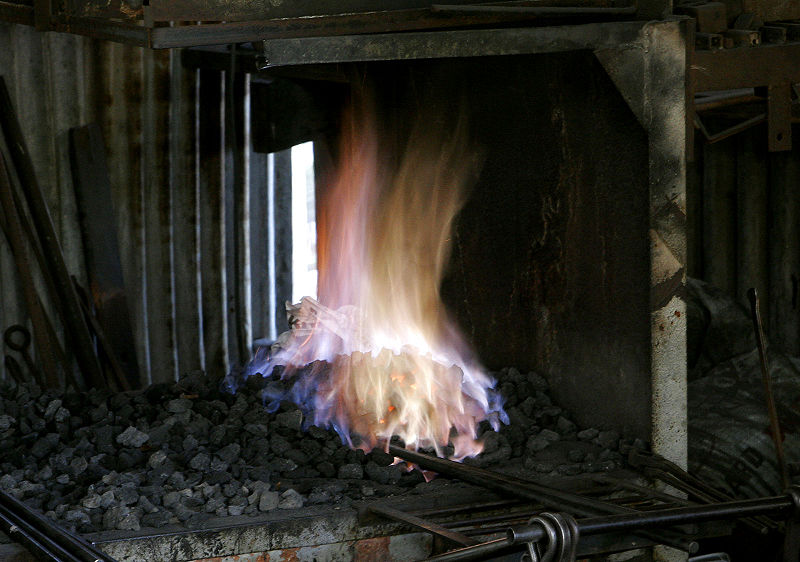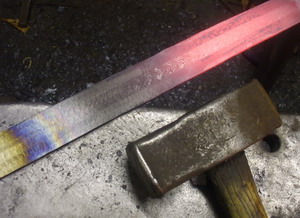The Germanic tribes of the Migration period were capable of stunning feats of metal-craft, from elegant pattern-welded swords to the intricate decoration and construction of elabourate helmets from the period. How did these technologies develop? What techniques were used, and what impact did the emergence of this mysterious art have on Germanic culture?
The Weland Connection
Clues to the emergence of smithcraft can be found by study of Germanic mythology.
Weland was the lame, semi-divine smith of the Anglo-Saxon pantheon, mentioned in Beowulf, Waldere and Deor's Lament whose father was said to be a giant, Wada. Weland was said to be responsible for any superlative, heirloom metal-work. His name is quite interesting, being cognate with our modern English word "Weld"(- to join metal together). This is thought to have Swedish origin from välla - to "well" ~ of the same meaning.
 |
| Weland's Smithy; neolithic site that settlers later associated with their Smith deity. |
Following his revenge on Nidud (King of the Finns), it is said that he flew away, on wings of his own construction, to the land of the elves, where he continued his marvelous smith-craft. Elves include in their ranks the Dwarves (Swearteielfe) renowned for their smith-craft and it is fascinating to speculate which swarthy race of human-beings was the primogenitor of these small, bearded talented smiths.
The early western continental German tribes evolved in the relatively metal-poor German plains and did not develop sophisticated arms and armour until quite late. They were unable to expand west of the Rhine until weapons-grade iron technology became available in the 3rd / 4th Century C.E.
It is then that the Smith-God gains a central, heroic place in mythology.
Who were these magic-working smiths who often went into their graves with the tools of their trade? It is likely that many farmers could put their hand to a little simple metal-working. Some who became more skilled would use the slack times of the farming year to make and repair farming implements and perhaps do a little bronze-casting. More skilled work would have been done by a dedicated village or town blacksmith. Kings and wealthy thegns would have their own skilled smiths. Some smiths, no doubt, were itinerant, probably carrying the heavy tools of their trade on a cart, but most military smiths would need a to be permanently based at one site, probably with a nearby source of iron-ore, charcoal and running-water.
Tools of the Trade
 The smith's forge (Old English smiððe) needed a fire which was usually raised from ground level in a clay hearth (heorðfyr). Near the fire would be an anvil (O.E. Anfilte) This would not be the large cast iron anvils we are used to but either a large hard stone or a tree-trunk with a layer of hardened iron on the top.It would have been this type of anvil that Sigfrið demolished in his trying out of the sword Gram. To raise the temperature of the fire, the smith would need a set of huge bellows (Old English Blæstbelg, byling) and a pair of muscular assistants to pump them.
The smith's forge (Old English smiððe) needed a fire which was usually raised from ground level in a clay hearth (heorðfyr). Near the fire would be an anvil (O.E. Anfilte) This would not be the large cast iron anvils we are used to but either a large hard stone or a tree-trunk with a layer of hardened iron on the top.It would have been this type of anvil that Sigfrið demolished in his trying out of the sword Gram. To raise the temperature of the fire, the smith would need a set of huge bellows (Old English Blæstbelg, byling) and a pair of muscular assistants to pump them.He would also need a variety of tools, including tongs (clawas) with which to manipulate the glowing metal, various hammers (hamor, bietl, slecg) to shape it, punches (bor) for making holes, shears (scearras) for cutting sheet metal, chisels (heardheaw, brædisen) for cutting thicker metal, files (feol) for smoothing and grindstones ( hwet-stan) for sharpening. He would also need a very large supply of hot-burning charcoal (alder is said to be the best). The term ‘charcoal’ derives from Old English cierran - to turn, change, plus col; but probably the Anglo-Saxon word was either 'gled' (glowing coal) or dyð.
For non-ferrous work he would need a supply of bronze and brass (bræs, ars), a crucible for melting the metal in (fyrcruce) and clay and sand for making moulds. Such a founder would have been called a Geotere- from the Old English word "to flow".
To be continued....

